

|
| HRVATSKA | CROATIA |
| županija: Istarska |
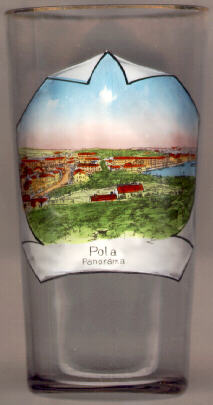
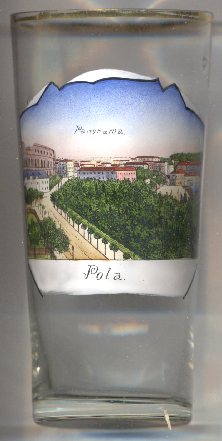 Pula is maybe the town with the longest history on the eastern Adriatic coast.
Archeological finds in the vicinity of Pula prove that the area was inhabited
already at about 40,000 BC. During the 5th century BC the Histrian tribe
set up a fortified settlement here. The Histri settlements were
conquered by the Romans in 177 BC who founded a colony called Colonia Iulia Pollentia Herculanea.
Under the rule of Emperor Augustus (from 30 BC until 14 AD) Pula (Pietas Iulia)
was the main administrative centre of Istria and already counted 30,000 inhabitants.
After the division of the old Roman Empire in the 4th century, the town was ruled in succession
by Ostrogoths (493–538), Byzantium (538–788) and Frankonians. From 1331 on, Pula (Italian: Pola)
was ruled by the Republic of Venice. The following centuries brought
a period of decline for the town; in the 17th century, there were only a few
hundred inhabitants left. After the war with Napoleon, Austria obtained most of the
Venetian Republic according to the Treaty of Campo Formio (today Campoformido)
in 1797. From then, Pula remained part of the Austrian Monarchy until 1918
(only interrupted by Napoleonic rule between 1805 and 1814/15).
After 1848, the year of the Revolution, Austria moved its military port from Venice to Pula.
This marked the beginning of a most prosperous period of the town. However, as
about one quarter of the population consisted of soldiers, the town had the
questionable reputation of an 'intellectual siberia'. In 1918, after the dissolution
of the Austro-Hungarian Empire, Pula became part of Italy. At the end of
World War II Pula was occupied by Yugoslav partisan troops in 1945.
However, it officially became part of Yugoslavia only in 1947. Since the break-up of Yugoslavia in 1991, Pula is part of the Republic of Croatia.
Pula is maybe the town with the longest history on the eastern Adriatic coast.
Archeological finds in the vicinity of Pula prove that the area was inhabited
already at about 40,000 BC. During the 5th century BC the Histrian tribe
set up a fortified settlement here. The Histri settlements were
conquered by the Romans in 177 BC who founded a colony called Colonia Iulia Pollentia Herculanea.
Under the rule of Emperor Augustus (from 30 BC until 14 AD) Pula (Pietas Iulia)
was the main administrative centre of Istria and already counted 30,000 inhabitants.
After the division of the old Roman Empire in the 4th century, the town was ruled in succession
by Ostrogoths (493–538), Byzantium (538–788) and Frankonians. From 1331 on, Pula (Italian: Pola)
was ruled by the Republic of Venice. The following centuries brought
a period of decline for the town; in the 17th century, there were only a few
hundred inhabitants left. After the war with Napoleon, Austria obtained most of the
Venetian Republic according to the Treaty of Campo Formio (today Campoformido)
in 1797. From then, Pula remained part of the Austrian Monarchy until 1918
(only interrupted by Napoleonic rule between 1805 and 1814/15).
After 1848, the year of the Revolution, Austria moved its military port from Venice to Pula.
This marked the beginning of a most prosperous period of the town. However, as
about one quarter of the population consisted of soldiers, the town had the
questionable reputation of an 'intellectual siberia'. In 1918, after the dissolution
of the Austro-Hungarian Empire, Pula became part of Italy. At the end of
World War II Pula was occupied by Yugoslav partisan troops in 1945.
However, it officially became part of Yugoslavia only in 1947. Since the break-up of Yugoslavia in 1991, Pula is part of the Republic of Croatia.
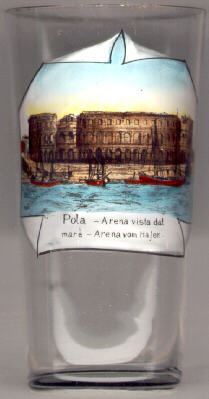
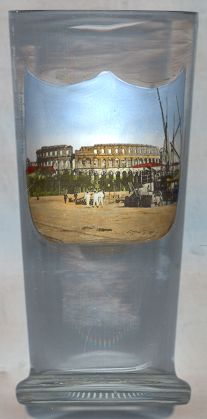
Certainly the most impressive building from Roman origin in Istria
is the  Arena [left and right],
the amphitheatre
built in the second half of the 1st century AD during the reign of
Emperor Vespasian (69–79 AD). According to a popular legend, the idea
came from Vespasians mistress, Antonia Cenida, who was a native of Pula.
Seen from the harbour, its monumental dimensions (length 132 m, width 105 m,
height 32 m) still are a reminder of the town's wealth and importance
in ancient times. It could accomodate 23,000 viewers at the popular
Roman spectacles and is the sixth in size of all of the remaining Roman
aphitheatres in the world. During the time of Venetian rule, the Arena also
served as a quarry, but a decree of 1583 by the Venetian senator Emo stopped
this practise so that the remainders of the Arena are still in use today for
concerts, theatrical or opera open-air performances.
Arena [left and right],
the amphitheatre
built in the second half of the 1st century AD during the reign of
Emperor Vespasian (69–79 AD). According to a popular legend, the idea
came from Vespasians mistress, Antonia Cenida, who was a native of Pula.
Seen from the harbour, its monumental dimensions (length 132 m, width 105 m,
height 32 m) still are a reminder of the town's wealth and importance
in ancient times. It could accomodate 23,000 viewers at the popular
Roman spectacles and is the sixth in size of all of the remaining Roman
aphitheatres in the world. During the time of Venetian rule, the Arena also
served as a quarry, but a decree of 1583 by the Venetian senator Emo stopped
this practise so that the remainders of the Arena are still in use today for
concerts, theatrical or opera open-air performances.
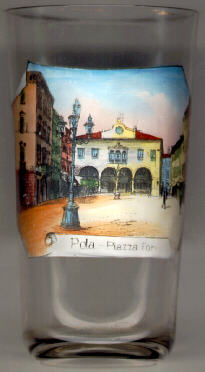
The old town centre has always been the place of the Roman forum.
The  Old Town Hall or Communal Palace [left]
was erected in 1296 in place of the Roman temple of Diana. During the
Renaissance, it obtained its present-day appreance with the loggia on the
ground floor. A later addition was the Baroque belfry on the roof.
Old Town Hall or Communal Palace [left]
was erected in 1296 in place of the Roman temple of Diana. During the
Renaissance, it obtained its present-day appreance with the loggia on the
ground floor. A later addition was the Baroque belfry on the roof.
The picture on the glass shows the Town Hall and the square
(then named 'Piazza foro') approximately at the beginning of the 19th century.
In the meantime, the belfry of the Town Hall has been removed to re-establish
a more 'pure' Renaissance appearance, and the row of houses on the left side
has been torn down so that the square is much more spacious today and also
allows the view to the ancient temple of Augustus to the left of the Town Hall.
The square today is called 'Trg Republike' ('Republic square').
![[scale]](lineal.jpg)